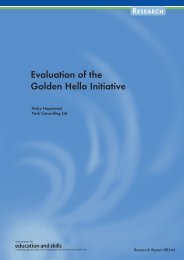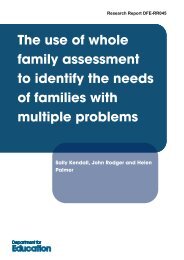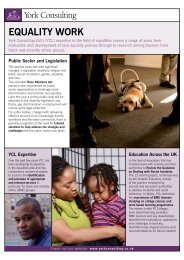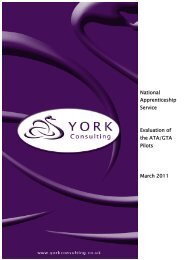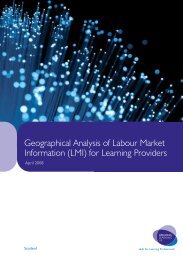Recruitment and Retention in the Post-16 Learning and Skills Sector
Recruitment and Retention in the Post-16 Learning and Skills Sector
Recruitment and Retention in the Post-16 Learning and Skills Sector
Create successful ePaper yourself
Turn your PDF publications into a flip-book with our unique Google optimized e-Paper software.
5.<strong>16</strong> Generally HR Managers did not feel that hard to fill vacancies forteach<strong>in</strong>g staff were hav<strong>in</strong>g an adverse impact on <strong>the</strong>ir <strong>in</strong>stitution’sperformance over <strong>the</strong> past year. Over three fifths of respondents (63%)felt that <strong>the</strong> impact was not very much or not at all. Only 4% <strong>in</strong>dicated ‘agreat deal’ of impact. Among those who <strong>in</strong>dicated ‘a great deal’ <strong>and</strong> ‘tosome extent’ by impact, <strong>the</strong> reasons given for <strong>the</strong>re response <strong>in</strong>cluded<strong>in</strong>creased pressure experience by o<strong>the</strong>r staff who covered <strong>the</strong>ir duties,<strong>the</strong> effect on students <strong>and</strong> an effect on teach<strong>in</strong>g consistency.5.17 Teacher/tra<strong>in</strong>er respondents were asked whe<strong>the</strong>r <strong>the</strong>y were aware ofany recruitment difficulties with<strong>in</strong> <strong>the</strong>ir organisation. Two fifths (40%)reported that <strong>the</strong>y were aware of recruitment difficulties. Some of <strong>the</strong>teachers considerations were different to those reported by HRmanagers.5.18 As might be expected, management staff were more aware ofrecruitment difficulties (54%) than teachers or tra<strong>in</strong>ers (35%), assessors(29%) <strong>and</strong> learn<strong>in</strong>g support workers (27%).5.19 Permanent employees were also more likely to be aware of recruitmentdifficulties (42%) than those on fixed term contracts (32%) <strong>and</strong> o<strong>the</strong>rcontracts (29%). Likewise, full-time employees were more aware ofrecruitment difficulties (43%) than part-time employees (30%).Respondents with longer service with<strong>in</strong> <strong>the</strong>ir organisation, <strong>and</strong> across<strong>the</strong> sector, were more aware of recruitment difficulties.5.20 Figure 5.2 presents <strong>the</strong> proportion of respondents aware of recruitmentdifficulties, by type of organisation. Respondents <strong>in</strong> fur<strong>the</strong>r educationcolleges were more aware of recruitment difficulties (50%) thanrespondents <strong>in</strong> voluntary organisations (39%), <strong>in</strong>-house tra<strong>in</strong><strong>in</strong>g (38%),sixth form colleges (36%), adult <strong>and</strong> community learn<strong>in</strong>g organisations(36%) <strong>and</strong> private tra<strong>in</strong><strong>in</strong>g organisations (33%). This higher awarenessamong FE colleges may be a reflection of <strong>the</strong>ir larger size.40



